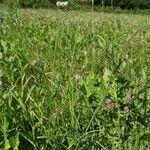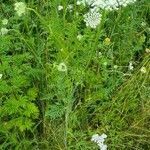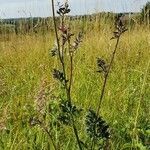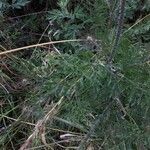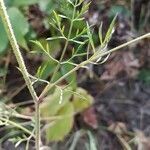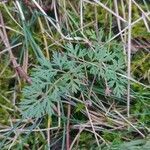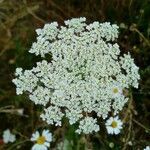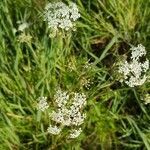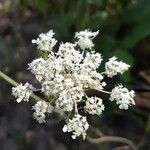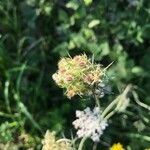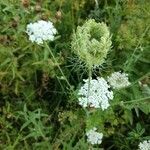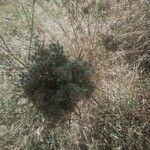Annual, biennial or perennial. Main root fusiform. Stems erect, striate or grooved, hirsute. Leaves 2-3-pinnatipartite, segments lanceolate. Compound umbels with flat or round surface when flowering, with incurved peduncles and pedicels and hollow surface in fruit; peduncles 2-25 cm; rays 15-30, 1-6 cm; pedicels 20-30, ½-1½ cm; involucres 3-5 cm, pinnatipartite, white-margined towards the base; involucels 5-7,½-2 cm, entire to pinnatipartite, lanceolate. Calyx teeth ¼-½ mm, triangular, acute. Petals white or dark red in 5-7 central sterile flowers of the central umbel, with inflexed tips, peripheric ones radiating. Mericarps 3 by 1½-2 mm, nearly oblong; primary ribs filiform with rather few nearly ¼ mm long, fine bristles, secondary ribs beset with nearly 1 mm long, rigid bristles.
Biennial with a stout taproot, 4–10 dm, hirsute to subglabrous; lvs oblong, pinnately decompound, the ultimate segments linear, lanceolate, or oblong; infl at anthesis showy, 4–12 cm wide, commonly narrower in fr, the outer rays longer than the others (to 7 cm) and arching inwards; bracts pinnatifid into firm, elongate, filiform-subulate segments, scarious-margined below the segments, spreading or reflexed in fr; umbellets with mostly (10–)20-numerous white or faintly yellowish fls (the central fl of the whole infl usually, the others rarely, purple or pink); fr 3–4 mm, broadest at the middle; 2n=18. Native of Eurasia, now a weed throughout most of N. Amer. The cultivated carrot is a race of this sp.
Plants to 120 cm. Leaves oblong, 2–3-pinnate/pinnatisect; ultimate segments linear to lanceolate, 2–15 × 0.5–4 mm, glabrous to hispid especially on the veins and margins, acute, mucronate. Peduncles 10–55 cm, retrorsely hispid; bracts foliaceous, pinnate, rarely entire, lobes linear, 3–30 mm, margin scarious; rays 2–7.5 cm, unequal; bracteoles 5–7, linear, entire or 2–3-lobed, more or less scarious and ciliate, equaling or exceeding flowers. Petals white, sometimes yellow or pinkish. Fruit 3–4 × ca. 2 mm. Fl. May–Jul.
Toxic, biennial herb, 0.3-1.8 m high; stem erect, with stiff, bristle-like hairs; taproot ± fleshy. Leaves bipinnate, lower ones with acute, lanceolate segments, upper ones much smaller and less divided. Flowers in terminal umbels; involucre conspicuous, with many, narrow, 3-forked bracts. Calyx minute. Petals broadly obovate, notched, white. Flower ing time Sept.-Apr. Fruit ellipsoid, with sharp bristles.
A plant that takes 2 years to complete its life-cycle. It grows 30 cm-1 m high. It spreads 15-60 cm wide. The leaves are finely divided. They are like feathers. The flowers are small and white and in groups. The groups can be 7 cm across. There are hairy bracts. The fruit are oval with spiny ridges.
Biennial herb, up to 1 m high. Leaves pinnate; ultimate leaf segments finely cut into many narrow segments. Umbels becoming strongly concave (forming a cup) in fruit. Flowers white to yellowish.
